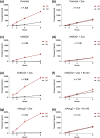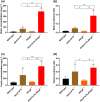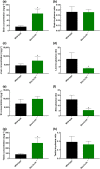OATP1A/1B, CYP3A, ABCB1, and ABCG2 limit oral availability of the NTRK inhibitor larotrectinib, while ABCB1 and ABCG2 also restrict its brain accumulation
- PMID: 32087611
- PMCID: PMC7279963
- DOI: 10.1111/bph.15034
OATP1A/1B, CYP3A, ABCB1, and ABCG2 limit oral availability of the NTRK inhibitor larotrectinib, while ABCB1 and ABCG2 also restrict its brain accumulation
Abstract
Background and purpose: Larotrectinib is a FDA-approved oral small-molecule inhibitor for treatment of neurotrophic tropomyosin receptor kinase fusion-positive cancer. We here investigated the functions of the multidrug efflux transporters ABCB1 and ABCG2, the SLCO1A/1B (OATP1A/1B) uptake transporters, and the multispecific drug-metabolizing enzyme CYP3A in larotrectinib pharmacokinetic behaviour.
Experimental approach: In vitro, transepithelial drug transport and uptake assays were performed. In vivo, larotrectinib (10 mg·kg-1 ) was administered orally to relevant genetically modified mouse models. Cell medium, plasma samples, and organ homogenates were measured by a sensitive and specific LC-MS/MS larotrectinib assay.
Key results: In vitro, larotrectinib was avidly transported by human (h) ABCB1 and mouse (m) Abcg2 efficiently by hABCG2 and modestly by hOATP1A2. In vivo, both mAbcb1a/1b and mAbcg2 markedly limited larotrectinib oral availability and brain and testis accumulation (by 2.1-fold, 10.4-fold, and 2.7-fold, respectively), with mAbcb1a/1b playing a more prominent role. mOatp1a/1b also restricted larotrectinib oral availability (by 3.8-fold) and overall tissue exposure, apparently by mediating substantial uptake into the liver, thus likely facilitating hepatobiliary excretion. Additionally, larotrectinib is an excellent substrate of CYP3A, which restricts the oral availability of larotrectinib and hence its tissue exposure.
Conclusions and implications: ABCG2 and especially ABCB1 limit the oral availability and brain and testis penetration of larotrectinib, while OATP1A/1B transporters restrict its systemic exposure by mediating hepatic uptake, thus allowing hepatobiliary excretion. CYP3A-mediated metabolism can strongly limit larotrectinib oral availability and hence its tissue concentrations. These insights may be useful in the further clinical development of larotrectinib.
© 2020 The British Pharmacological Society.
Conflict of interest statement
The research group of A.H.S. receives revenue from commercial distribution of some of the mouse strains used in this study. The remaining authors declare no conflicts of interest.
Figures







Similar articles
-
Rifampin and ritonavir increase oral availability and elacridar enhances overall exposure and brain accumulation of the NTRK inhibitor larotrectinib.Eur J Pharm Biopharm. 2022 Jan;170:197-207. doi: 10.1016/j.ejpb.2021.12.007. Epub 2021 Dec 21. Eur J Pharm Biopharm. 2022. PMID: 34952136
-
ABCB1 and ABCG2, but not CYP3A4 limit oral availability and brain accumulation of the RET inhibitor pralsetinib.Pharmacol Res. 2021 Oct;172:105850. doi: 10.1016/j.phrs.2021.105850. Epub 2021 Aug 25. Pharmacol Res. 2021. PMID: 34450308
-
P-glycoprotein and breast cancer resistance protein restrict brigatinib brain accumulation and toxicity, and, alongside CYP3A, limit its oral availability.Pharmacol Res. 2018 Nov;137:47-55. doi: 10.1016/j.phrs.2018.09.020. Epub 2018 Sep 22. Pharmacol Res. 2018. PMID: 30253203
-
ABCB1 and ABCG2 Restrict Brain and Testis Accumulation and, Alongside CYP3A, Limit Oral Availability of the Novel TRK Inhibitor Selitrectinib.Mol Cancer Ther. 2021 Jun;20(6):1173-1182. doi: 10.1158/1535-7163.MCT-20-0705. Epub 2021 Mar 30. Mol Cancer Ther. 2021. PMID: 33785654
-
Larotrectinib for solid tumours.Aust Prescr. 2022 Jun;45(3):97-98. doi: 10.18773/austprescr.2022.030. Epub 2022 Jun 1. Aust Prescr. 2022. PMID: 35755993 Free PMC article. Review. No abstract available.
Cited by
-
Involvement of Transporters in Intestinal Drug-Drug Interactions of Oral Targeted Anticancer Drugs Assessed by Changes in Drug Absorption Time.Pharmaceutics. 2022 Nov 17;14(11):2493. doi: 10.3390/pharmaceutics14112493. Pharmaceutics. 2022. PMID: 36432682 Free PMC article.
-
Role of Drug Transporters in Elucidating Inter-Individual Variability in Pediatric Chemotherapy-Related Toxicities and Response.Pharmaceuticals (Basel). 2022 Aug 11;15(8):990. doi: 10.3390/ph15080990. Pharmaceuticals (Basel). 2022. PMID: 36015138 Free PMC article. Review.
-
P-Glycoprotein (ABCB1/MDR1) and BCRP (ABCG2) Limit Brain Accumulation and Cytochrome P450-3A (CYP3A) Restricts Oral Exposure of the RET Inhibitor Selpercatinib (RETEVMO).Pharmaceuticals (Basel). 2021 Oct 27;14(11):1087. doi: 10.3390/ph14111087. Pharmaceuticals (Basel). 2021. PMID: 34832869 Free PMC article.
-
Boosting the oral bioavailability of anticancer drugs through intentional drug-drug interactions.Basic Clin Pharmacol Toxicol. 2022 Jan;130 Suppl 1(Suppl 1):23-35. doi: 10.1111/bcpt.13623. Epub 2021 Jun 28. Basic Clin Pharmacol Toxicol. 2022. PMID: 34117715 Free PMC article. Review.
-
Limb salvage of an infant with infantile fibrosarcoma using TRK inhibitor larotrectinib.Ecancermedicalscience. 2023 Jul 19;17:1575. doi: 10.3332/ecancer.2023.1575. eCollection 2023. Ecancermedicalscience. 2023. PMID: 37533946 Free PMC article.
References
-
- Bakos, E. , Evers, R. , Calenda, G. , Tusnady, G. E. , Szakacs, G. , Varadi, A. , & Sarkadi, B. (2000). Characterization of the amino‐terminal regions in the human multidrug resistance protein (MRP1). Journal of Cell Science, 113(Pt 24), 4451–4461. - PubMed
Publication types
MeSH terms
Substances
Grants and funding
LinkOut - more resources
Full Text Sources
Molecular Biology Databases

